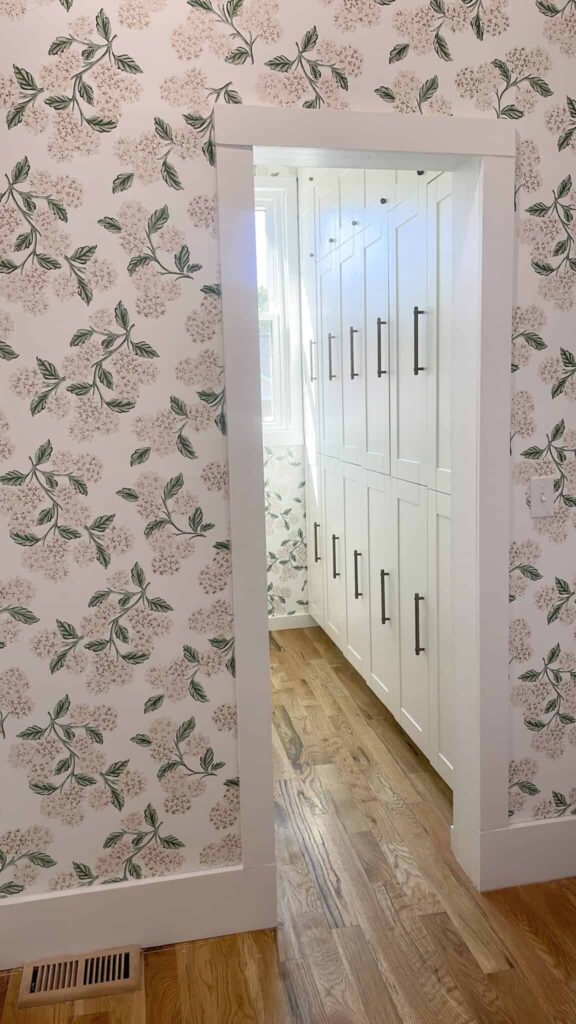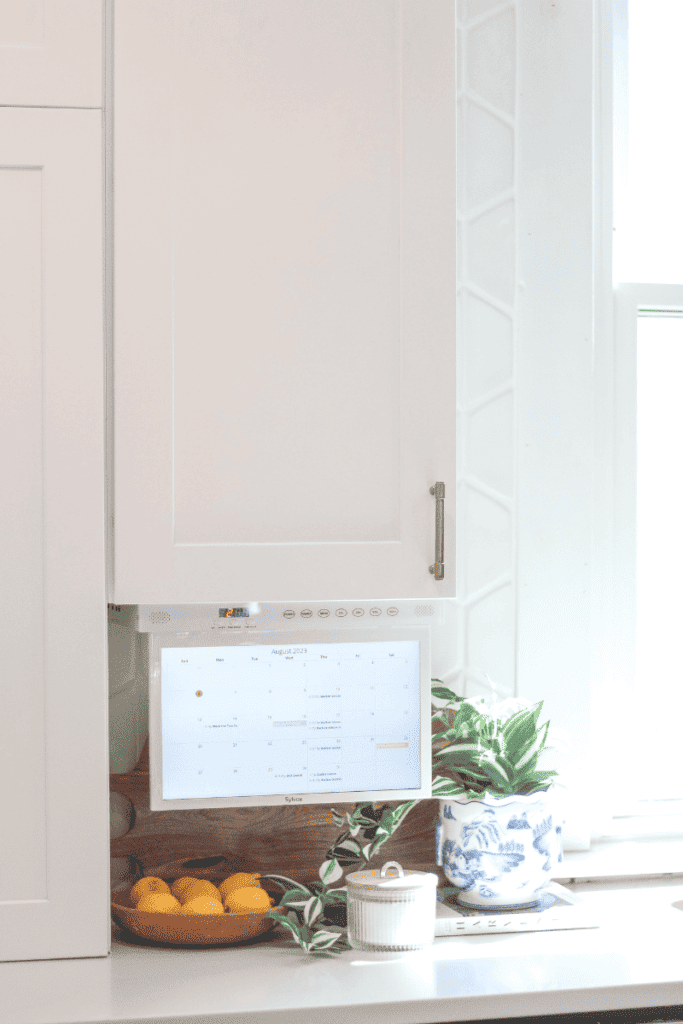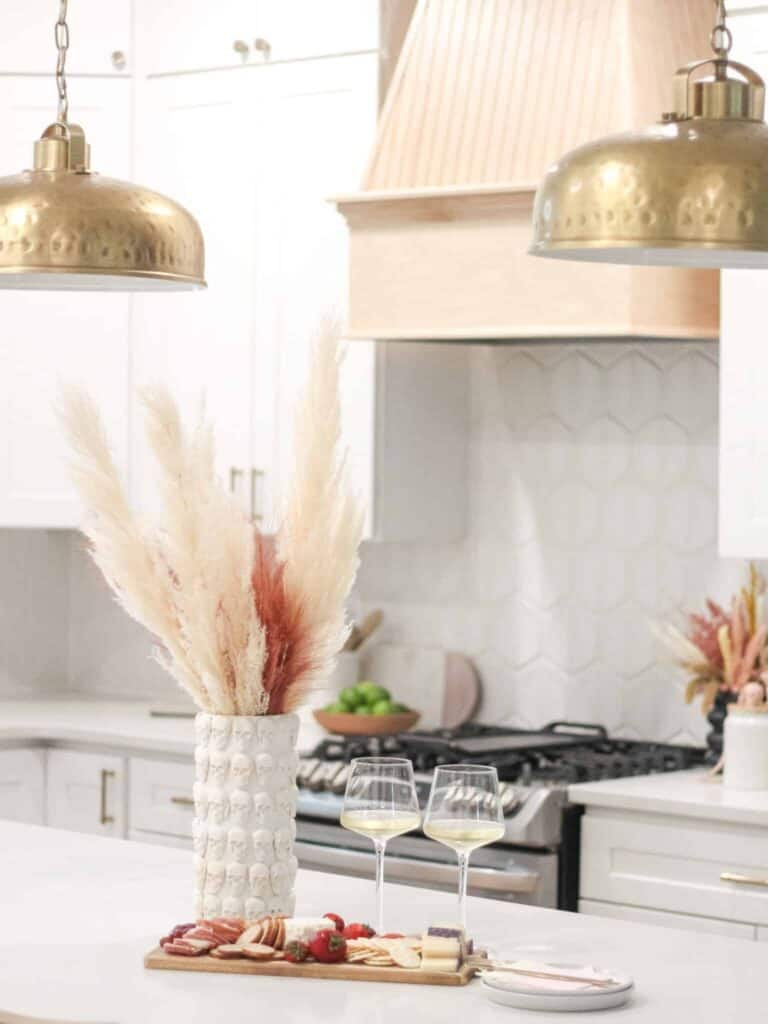If you’re remodeling your kitchen, a guide on kitchen cabinet dimensions is a must-read. We will break down everything you need to know about upper kitchen cabinet dimensions to help you plan your dream kitchen with a killer layout.
This post may contain affiliate links.

A Guide On Upper Kitchen Cabinet Dimensions
When planning a kitchen renovation or installing new kitchen cabinets, understanding the standard dimensions for upper kitchen cabinets is essential to ensure a functional and aesthetically pleasing kitchen layout.
I’ve had my fair share of kitchens over the years. While my kitchens have ranged in sizes, layouts, and design, the overall function has always been paramount.
Whether you are collaborating with a kitchen designer, choosing stock cabinets, or considering semi-custom options, knowing the standard sizes will help you make informed decisions.

Upper Cabinets: The Basics
Upper kitchen cabinets, also known as wall cabinets, are essential for storing kitchen essentials and food items while keeping them within easy access. These cabinets are mounted above the counters, typically over the base cabinets. They can significantly affect the overall look and functionality of your kitchen.
Upper kitchen cabinets, while primarily functional, also play a significant role in the overall aesthetic of your kitchen. There are various types and styles to consider when choosing the right cabinets for your space.
Here’s a breakdown of the most common types and styles:
Standard Wall Cabinets
These are the most common upper cabinets, typically ranging in height from 30 to 42 inches and in depth from 12 to 18 inches.

Corner Wall Cabinets
Designed to fit into a corner of the kitchen, these can either be diagonal or have a blind corner. They maximize space in otherwise hard-to-utilize corner areas.
Bridge (Or Over-The-Fridge) Cabinets
These are shorter cabinets used to bridge two taller sections of cabinetry, often placed above the refrigerator, microwave, or other tall appliances.
Specialty Units
These include cabinets like those with glass doors for display, open shelving for a lighter look, or wine racks for bottle storage.

Tall Upper Cabinets
In kitchens with high ceilings, upper cabinets might extend closer to the ceiling for additional storage.
Cabinet With Microwave Shelf
Specially designed to accommodate a microwave oven, these cabinets often have a designated spot that allows for ventilation.

Styles Of Upper Kitchen Cabinets
The style of an upper kitchen cabinet refers to the design of the cabinet door and can significantly influence the kitchen’s overall look.
Depending on your decor, you may prefer one style over another. Keep in mind that the more embellishments and detail a cabinet has can increase the price significantly.
While stock cabinets tend to be basic and flat, custom cabinetry can get very pricey.
Here are some of the options for cabinet styles:
Shaker
Known for their simple, clean lines with a recessed panel, Shaker cabinets are versatile and can fit into both traditional and contemporary designs.

Flat Panel (Slab)
These cabinets have a flat, single-piece door front and offer a sleek, minimalist look that works well in modern kitchens.
Raised Panel
These have a central panel that is raised with a profile or contour. Raised panel cabinets are often found in more traditional or classical kitchen designs.
Bead-Board
With a door style that features vertical grooves, bead-board cabinets lend a cottage or country feel to the kitchen.

Glass-Front
Either partially or fully made with glass panes, these cabinets are great for displaying items while keeping them dust-free.
This is a great way to add dimension and play off the lighting in a kitchen. However, you’ll need to have tidy cabinets to get the full effect.
Louvered
Comprising horizontal wood slats, louvered cabinet doors add a unique architectural style to the kitchen.

Cabinet Door Mounting Options
Mounting your cabinet doors is important as you’ll want everything to be square and level. Otherwise, the cabinet doors won’t shut fully or function well.
Before you hang your cabinet doors, consider how the cabinet will be mounted, which also affects your overall aesthetic.
Here are the two main options for mounting your cabinet doors:
Overlay
There are two main types of overlays—full overlay doors cover the entire face frame of the cabinet, while partial or standard overlay doors let the frame show around the doors, offering a more traditional appearance.
Inset
Inset doors are set inside the cabinet frame and flush with the front edges of the cabinet, giving a clean, precise look.

Cabinet Finish And Material
Cabinets can be made from various materials and finished in several ways. Each of these differences have pros and cons and a unique aesthetic.
These are the main types of cabinet materials and finishes:
Wood
A traditional choice, available in many types, stains, and finishes, from maple and oak to cherry and hickory.
Wood is durable and more likely to hold up for years to come. However, wood comes with a costly price tag.
Laminate
A more budget-friendly option that can mimic the look of wood or other finishes.
The durability of laminate tends to be more on the flimsy side. However, it is still an option for budget picks.

Thermofoil
A plastic coating applied to MDF, offering a durable and easy-to-clean surface.
Metal
Stainless steel or aluminum cabinets can give a professional, commercial kitchen look.
This is not often seen in most homes. You’ll likely see this material used in professional kitchens.
Painted
Wood or MDF cabinets can be painted in any color, providing a wide range of customization options to match your kitchen’s color scheme.
We’ve done our fair share of cabinet painting. I love how a simple coat of fresh paint can transform an entire room. If you are looking for tips to paint your cabinets, make sure you check out DIY on painting our cabinets white.
There’s also some great information on choosing the best paint for cabinets and the best clear coat for painted cabinets.

Decorative Elements
To further customize the style of your upper kitchen cabinets, consider adding decorative elements such as:
Crown Molding
This trim is installed at the top of the cabinets to add a decorative element and to gracefully connect the cabinets to the ceiling.
Corbels
Decorative supports that can be added beneath wall cabinets for a traditional or ornate look.
Glass Inserts
You can choose from various types of glass such as frosted, seeded, or stained to personalize glass-front cabinets.

Lighting
Installing under-cabinet lighting can enhance the functionality of the workspace and add ambiance.
Hardware
The knobs and pulls on cabinet doors and drawers are the jewelry of the kitchen and can significantly affect the overall design aesthetic.
Options range from modern, minimalist styles to ornate, traditional designs.
I love how changing out the cabinet’s hardware can make a big impact on the overall look of a kitchen. Make sure you check out the best kitchen cabinet handles.

Customization Options
While many upper cabinets come in standard sizes, there’s also the option to have cabinets custom-made or semi-customized to fit your specific needs and preferences.
When selecting the right type and style of upper kitchen cabinets for your home, it’s important to consider both the functional aspects—such as size, storage capacity, and ease of access—and the aesthetic qualities that will complement and enhance your kitchen’s design.
Whether you’re aiming for a traditional, transitional, or modern kitchen, the vast array of cabinet options available can be tailored to meet your vision and requirements.
Keep in mind that stock cabinets can be a great option to DIY your own customization. If DIY is not your thing, then custom or semi-custom cabinets can be ordered for a premium.
Customization can include:

Unique Dimensions
For kitchens with unusual layouts or specific storage needs, cabinets can be built to fit exact dimensions.
Organization Accessories
Built-in spice racks, plate holders, or appliance garages can help keep the kitchen organized and functional.
Adjustable Shelving
Some cabinets come with adjustable shelving, allowing you to modify the interior space to suit your storage needs.
Soft-Close Hinges
These hinges prevent doors from slamming shut, reducing noise and wear on the cabinets.

Upper Kitchen Cabinet Sizes & Dimensions
Remodeling a kitchen is a big project. Once you determine your wish list, decor style, and budget, you can start to look specifically into cabinets and sizes.
Your kitchen’s layout is going to dictate heavily on the size and type of cabinets you can have in your home.
Ceiling height, square footage, and budget play a big role in setting up your cabinet’s layouts.
Keep in mind that not every kitchen is the same. Sizes will vary pending your needs and overall budget.

Kitchen Cabinet Measurements: Accuracy Is Key
Accurate measurements are the cornerstone of any successful kitchen renovation.
When planning your layout, take into consideration all kitchen appliances, kitchen islands, and ensure there is enough space for the natural flow of traffic.
Also, consider the placement of kitchen essentials for easy access—keep everyday items within arm’s reach, while lesser-used items can be stored higher up or in less accessible areas.

Standard Upper Cabinet Sizes
The standard height for upper cabinets is typically 30, 36, or 42 inches, while the standard depth is 12 inches for wall cabinets, which suits most needs.
However, for kitchens with a larger floor plan or for homeowners who require more storage space, deeper cabinets of 15 to 18 inches may be the best option.
Standard widths for upper cabinets range from 9 to 48 inches, often increasing in 3-inch increments.

Upper Cabinet Height & Ceiling Height
A critical factor in setting the height of upper cabinets is the ceiling height of your kitchen.
The standard kitchen ceiling height is 96 inches (8 feet), and the upper cabinets are usually positioned so that their tops align with the top of the tall cabinets or pantry cabinets. This often allows for crown molding to be added for a finished look.
If the ceiling is higher than 9 feet, you may opt for taller cabinets, while ensuring there is still enough space (usually 18 to 20 inches) between the countertop and the bottom of the upper cabinets.

Tall Cabinets & Utility Cabinets
Tall kitchen cabinets, such as pantry cabinets, are designed to extend from the floor to the ceiling. Their standard height can be 84, 90, or 96 inches to align with the ceiling or upper cabinets.
Utility cabinets are similar but may have a toe kick at the bottom, aligning them with standard base cabinets, which have a standard base cabinet height of 34.5 inches plus a 1.5-inch countertop, totaling 36 inches.

Special Considerations For Upper Kitchen Cabinets
When designing your dream kitchen, you may encounter spaces that require special consideration.
For example, blind corner base cabinets or blind corner cabinets can maximize storage space in corners. Lazy Susan cabinets or other corner solutions can make these tricky spaces more functional. Filler cabinets may be used to fill gaps and ensure a seamless look.
For appliances like microwave ovens, consider the microwave oven cabinet, which is designed to fit the appliance perfectly and offer easier access.
For high cabinets, ensure that the items you use less frequently are stored at the top, while everyday items are placed at a more accessible height.
Customizing For Special Needs
While standard kitchen cabinet dimensions work for most, customizing for special needs or preferences is vital for the perfect kitchen.
If you have a kitchen island, additional storage can be incorporated with base kitchen cabinets. For those who are taller or shorter than average, or for those with special needs, the heights and depths of cabinets can be adjusted for maximum comfort and efficiency.

Other Kitchen Cabinet Considerations
While this posts primarily focuses on upper kitchen cabinets, I’d be remiss if I didn’t touch on other kitchen cabinets.
Whether you are replacing current cabinetry or completing a full kitchen renovation, knowing the types of cabinets is important.
Upper kitchen cabinets tend to be not only functional but also pretty. Your eyes are naturally drawn upward and the upper kitchen cabinets are often the first thing people notice when they walk in the room.
However, base cabinets and drawer fronts are just as important for the kitchen’s function and decor.

Standard Base Cabinets and Toe Kicks
Standard base cabinets are the workhorse of the kitchen.
They are typically 24 inches deep, not including the countertop overhang. This depth provides sufficient storage while allowing for a comfortable reach to the back of the cabinet.
The toe kick, which is the recessed space at the bottom of the cabinet, allows you to stand closer to the counter, improving comfort during tasks such as chopping or mixing. Toe kicks are generally 4 inches high and 3 inches deep.
Check out more information on standard base cabinet dimensions.

Kitchen Cabinet Depth & Full-Height Base Cabinets
Full-height base cabinets are a popular choice for maximizing storage space.
These cabinets, which do not have a drawer at the top, can offer uninterrupted storage space that’s ideal for items like baking sheets and trays.
If you opt for deeper cabinets, be mindful that while they offer increased storage capacity, they may also make it more difficult to reach items at the back.
Cabinet Doors & Drawer Fronts
The style of cabinet doors and drawer fronts can influence the look of your kitchen.
Options range from flat-panel doors for a modern look to raised-panel doors for a more traditional aesthetic. When choosing cabinets, consider the ease of cleaning, as some designs may collect dust and grime more easily.

Optimizing Storage With Cabinet Types
It is no secret that I love organizing my spaces, especially my pantry and kitchen.
There are various types of kitchen cabinets to optimize storage. Lazy Susans, mentioned earlier, offer a solution for corner cabinets, while pull-out drawers can make it easier to reach items at the back of the cabinet.
Appliance garages can be used to store small kitchen appliances, keeping them accessible yet out of sight when not in use.
If you are looking for organizational tools that can be easily installed and purchased, make sure you check out my round up below.

Designing With A Kitchen Designer Or Interior Designers
Working with a kitchen designer or interior designers can help you navigate the myriad options and configurations for your new kitchen cabinets. This can be especially important as a first time renovator or home buyer.
These professionals can advise on the best kitchen cabinets for your space, considering both style and function. They can also suggest modifications to standard cabinet sizes to better suit the specific dimensions and layout of your kitchen.

Shop My Favorite Kitchen Organizational Tools
Check out my favorite organizational finds for my kitchen.

1 | 2 | 3 | 4 | 5 | 6 | 7 | 8 | 9 | 10 | 11 | 12 | 13 | 14 | 15 | 16 | 17 | 18
Spice Organizer
Water Bottle Storage
Tea Storage
Canisters
Coffee Cup Organizer
Bamboo Drawer Organizer
Pots and Pans Organizer
Cutting Board and Cookie Sheet Organizer
Bamboo Tupperware Organizer
Dish Organizer
Lid Organizer
Bamboo Bag Organizer
Lazy Susan
Acrylic Bins
Under Sink Mat
Corner Cabinet Lazy Susan
Under Sink Organizer
Set Of Acrylic Bins
Other Posts You’ll Love
High End Kitchen Cabinet Brands | Standard Kitchen Base Cabinet Dimensions | Blind Corner Kitchen Cabinet Ideas For Smart Storage
Pin The Photo Below For Later
Choosing the right kitchen cabinet sizes is crucial for a well-functioning kitchen. Whether you opt for standard kitchen cabinet dimensions, semi-custom cabinets, or a fully custom design, your goal should be to create a space that is both beautiful and practical.
Keep in mind the standard cabinet heights, depths, and widths, but don’t be afraid to tailor these dimensions to fit your specific needs or the special features of your new home. By considering all aspects of cabinet dimensions, you can ensure your kitchen renovation is a success, granting you that dream kitchen with the perfect blend of form and function.

